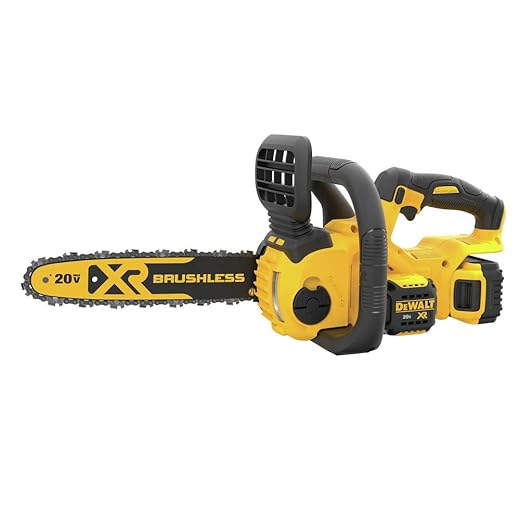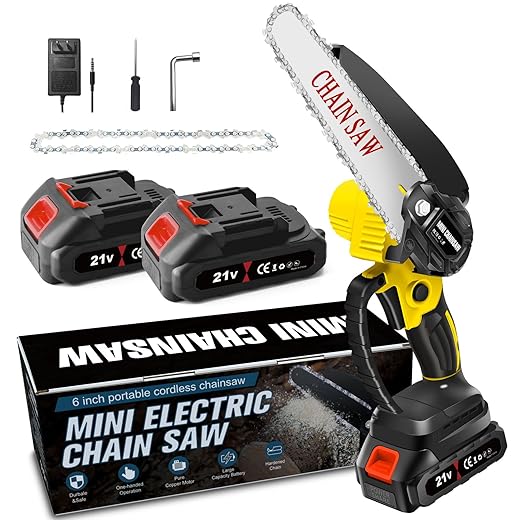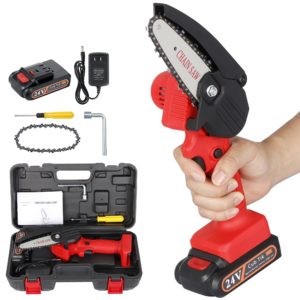A cordless electric chainsaw is a cutting tool that operates without the need for a power cord or fuel. It is powered by a rechargeable battery, providing convenience and mobility for various cutting tasks. Cordless electric chainsaws are typically designed to be lightweight, portable, and easy to maneuver, making them suitable for homeowners, DIY enthusiasts, and professionals who require a versatile and efficient cutting tool.
These chainsaws offer the advantage of quiet operation, low maintenance requirements, and reduced emissions compared to traditional gasoline-powered chainsaws. They are commonly used for tasks such as pruning, trimming, cutting firewood, and small to medium-scale woodworking projects.
Cordless electric chainsaws are available in different sizes and power levels, allowing users to choose the model that best suits their specific cutting needs. With advancements in battery technology, many cordless electric chainsaws offer extended runtimes and sufficient power to handle a wide range of cutting applications.
What are the uses of a cordless electric chainsaw?
Cordless electric chainsaws are versatile tools that can be used for a variety of cutting tasks. Here are some common uses of a cordless electric chainsaw:
- Pruning and Trimming: Cordless electric chainsaws are excellent for pruning and trimming trees, shrubs, and hedges. Their compact size and maneuverability make them ideal for precision cutting in tight spaces.
- Limbing: When removing branches from felled trees or fallen branches, a cordless electric chainsaw can be used for efficient limb removal. Its portability allows for easy access to branches in different locations.
- Firewood Cutting: Cordless electric chainsaws are suitable for cutting firewood. They can handle smaller to medium-sized logs and provide convenience in areas where access to electricity or fuel may be limited.
- DIY Woodworking: For small-scale woodworking projects, such as crafting furniture or making custom pieces, a cordless electric chainsaw can be a handy tool. It allows for precise cuts and shaping of wood.
- Home Maintenance: Cordless electric chainsaws can assist with various home maintenance tasks, such as cutting through wooden posts, removing unwanted branches, or tackling yard cleanup after storms.
- Construction and Demolition: In construction or demolition projects, a cordless electric chainsaw can be useful for cutting through wooden beams, joists, or other structural elements.
- Landscaping and Gardening: Cordless electric chainsaws are valuable tools for maintaining landscapes and gardens. They can be used to clear overgrown vegetation, remove unwanted tree saplings, or shape hedges and bushes.
- Emergency Preparedness: Having a cordless electric chainsaw as part of your emergency kit can be advantageous during natural disasters or power outages. It allows you to clear debris and fallen branches to ensure safety and access.
These are just some of the many uses of a cordless electric chainsaw. Their versatility, portability, and ease of use make them valuable tools for homeowners, DIY enthusiasts, gardeners, and professionals in various industries.
Is a cordless electric chainsaw powerful enough?
Cordless electric chainsaws have made significant advancements in power and performance in recent years. While they may not match the power output of their gas-powered counterparts, they are generally powerful enough for a wide range of cutting tasks, especially those intended for light to medium-duty applications.
The power of a cordless electric chainsaw is primarily determined by the voltage and design of the battery and the efficiency of the motor. Higher voltage batteries, such as 40V or 60V, generally provide more power and longer runtimes. Modern cordless electric chainsaws often feature brushless motors that optimize power delivery and enhance efficiency.
For most typical household tasks, such as pruning, trimming, and cutting small to medium-sized logs or branches, a cordless electric chainsaw is more than capable. They can easily handle routine yard work, firewood cutting, and general maintenance tasks.
However, it’s important to note that if you regularly encounter heavy-duty cutting tasks or need to fell larger trees, a gas-powered chainsaw or a larger electric chainsaw with a cord might be more suitable. These types of chainsaws generally offer greater power and cutting capacity.
When considering the power of a cordless electric chainsaw, it’s essential to match the tool to the intended tasks. Review the manufacturer’s specifications, including the maximum cutting diameter and chain speed, to ensure they align with your cutting needs.
Overall, cordless electric chainsaws have come a long way in terms of power and performance, and they continue to improve with advancements in battery and motor technology. For most homeowners and DIY enthusiasts, a well-designed cordless electric chainsaw provides ample power for their cutting needs while offering the convenience of cordless operation.
What are the benefits of cordless electric chainsaw?
Cordless electric chainsaws offer several benefits that make them a popular choice among homeowners, DIY enthusiasts, and professionals. Here are some of the advantages of using a cordless electric chainsaw:
- Portability and Mobility: One of the primary benefits of cordless electric chainsaws is their portability. They operate without a power cord, allowing users to move freely without restrictions or the need for an external power source. This makes them ideal for working in remote areas, tight spaces, or locations where access to electricity is limited.
- Reduced Noise and Emissions: Compared to gas-powered chainsaws, cordless electric chainsaws produce significantly less noise and emit zero exhaust fumes. This makes them more environmentally friendly and reduces the disturbance to the user and the surrounding environment. It also allows for quieter operation, which can be advantageous in residential areas or noise-sensitive locations.
- Ease of Use: Cordless electric chainsaws are generally lightweight and easy to handle, making them user-friendly, especially for beginners or those with less experience operating chainsaws. They often have ergonomic designs, vibration reduction features, and intuitive controls that enhance user comfort and control during operation.
- Low Maintenance: Cordless electric chainsaws require less maintenance compared to gas-powered chainsaws. They don’t require fuel mixing, spark plug changes, or air filter cleaning. With fewer moving parts, maintenance tasks are typically limited to chain tensioning, chain lubrication, and occasional cleaning.
- Quick Start: Cordless electric chainsaws start with a simple push of a button or trigger, eliminating the need for pull-starts or choke adjustments. This makes them easier to start and reduces the hassle of traditional starting mechanisms.
- Reduced Vibrations: Cordless electric chainsaws generally have lower vibration levels compared to gas-powered chainsaws. This reduces user fatigue and makes the chainsaw more comfortable to handle during prolonged use.
- Environmental Friendliness: As cordless electric chainsaws do not rely on gasoline or emit exhaust fumes, they are considered more environmentally friendly. They contribute to cleaner air quality and help reduce the carbon footprint associated with traditional gas-powered chainsaws.
- Convenience: With advancements in battery technology, cordless electric chainsaws now offer longer runtimes and faster charging times. This allows for extended cutting sessions and reduces downtime waiting for the battery to recharge.
While cordless electric chainsaws may not offer the same power as gas-powered models, they excel in terms of convenience, ease of use, reduced maintenance, and environmental considerations. They are well-suited for a variety of cutting tasks around the home, garden, and other areas where a portable and quieter chainsaw is desired.
What to look for when buying a cordless electric chainsaw?
When buying a cordless electric chainsaw, there are several key factors to consider to ensure you choose the right tool for your needs. Here are some important things to look for:
- Power and Performance: Check the voltage of the chainsaw’s battery, as it directly affects the power and cutting capacity. Higher voltage batteries generally provide more power and longer runtimes. Consider the maximum cutting diameter and chain speed to determine if the chainsaw is suitable for your intended tasks.
- Battery Life and Runtime: Evaluate the battery life and runtime of the chainsaw. Look for information on how long the battery can operate before requiring a recharge. Consider the type of battery technology used (e.g., lithium-ion) and whether the chainsaw offers interchangeable batteries for extended use.
- Charging Time: Consider the charging time required to fully recharge the battery. Shorter charging times can be more convenient, especially when you need to continue working without much downtime.
- Chain and Bar Length: The length of the cutting chain and bar determines the maximum diameter of the wood the chainsaw can cut. Consider the size of the trees or branches you typically work with and choose a chainsaw with an appropriate chain and bar length.
- Safety Features: Look for safety features such as chain brakes, kickback protection, and ergonomic design with comfortable handles and grips. These features contribute to safer operation and reduce the risk of accidents or injuries.
- Weight and Ergonomics: Consider the weight and ergonomics of the chainsaw. A lighter chainsaw is generally easier to maneuver and causes less user fatigue during extended use. Look for models with ergonomic designs that provide a comfortable grip and balance.
- Durability and Build Quality: Check the build quality and materials used in the construction of the chainsaw. Look for sturdy, durable materials that can withstand regular use and potentially harsh conditions.
- Brand Reputation and Reviews: Research the reputation of the brand and read customer reviews to get insights into the reliability, performance, and customer satisfaction of the chainsaw model you’re considering.
- Warranty and Support: Check the warranty offered by the manufacturer and the availability of customer support or service centers. A good warranty provides assurance and support in case of any issues with the chainsaw.
- Price and Value for Money: Consider your budget and the overall value for money the chainsaw provides. Compare the features, performance, and reliability of different models to find the one that offers the best balance between price and functionality.
By considering these factors, you can make an informed decision and choose a cordless electric chainsaw that meets your specific needs and provides a satisfying cutting experience.
How many watts does a cordless electric chainsaw need?
The power requirement of a cordless electric chainsaw is typically measured in volts (V), not watts (W). The voltage rating of the battery used in a cordless electric chainsaw determines the power output and performance of the tool.
Cordless electric chainsaws are available in various voltage options, ranging from 18V to 80V or even higher. The higher the voltage, the more power the chainsaw can deliver. Generally, cordless electric chainsaws with higher voltage batteries offer greater cutting capacity and longer runtimes.
It’s important to note that the power output of a chainsaw is not solely determined by the voltage of the battery. The design and efficiency of the motor, as well as the chain and bar length, also play a significant role in the overall cutting performance.
When choosing a cordless electric chainsaw, consider the voltage rating that suits your intended cutting tasks. Smaller chainsaws with lower voltage batteries (e.g., 18V to 40V) are suitable for light to medium-duty tasks, such as pruning and trimming. If you require more power for larger logs or heavier cutting applications, consider a chainsaw with a higher voltage battery (e.g., 60V or higher).
It’s worth mentioning that wattage (W) is a measure of power, and it can be calculated by multiplying the voltage (V) by the current (A). However, the wattage of a cordless electric chainsaw is not typically specified by manufacturers, as voltage is the primary indicator of power output for these tools.
Does cordless electric chainsaw use oil?
Yes, cordless electric chainsaws do require oil for proper operation. The oil is used to lubricate the chain and bar, reducing friction and preventing overheating during cutting. Lubrication is essential to maintain the performance and longevity of the chainsaw.
Cordless electric chainsaws typically have an automatic oiling system that releases oil onto the chain and bar as needed during operation. This system ensures consistent lubrication while minimizing oil wastage.
When using a cordless electric chainsaw, it is important to regularly check the oil level in the reservoir and refill it as necessary. Use the recommended bar and chain oil specified by the manufacturer for optimal performance. Avoid using other types of oil, such as motor oil or vegetable oil, as they may not provide adequate lubrication and can damage the chainsaw.
Proper lubrication helps to reduce chain wear, prolong the life of the cutting components, and ensure smooth and efficient cutting. It also helps to dissipate heat generated during operation, preventing damage to the chain and bar.
Remember to follow the manufacturer’s instructions regarding oiling and maintenance to keep your cordless electric chainsaw in good working condition.
What happens if you run a cordless electric chainsaw without oil?
Running a cordless electric chainsaw without oil or with insufficient oil can have negative consequences on the chainsaw’s performance and longevity. Here are some potential issues that may arise:
- Increased Friction and Heat: The chain and bar of the chainsaw rely on proper lubrication to reduce friction during cutting. Without sufficient oil, the friction between the chain and bar increases significantly. This can lead to excessive heat buildup, causing damage to the chain, bar, and other components of the chainsaw.
- Premature Chain and Bar Wear: Insufficient lubrication can result in accelerated wear of the chain and bar. The lack of oil creates metal-on-metal contact, causing increased friction, heat, and wear on the cutting components. Over time, this can lead to a dull chain, reduced cutting performance, and the need for more frequent chain replacements.
- Chain Dulling and Reduced Cutting Efficiency: The absence of oil results in poor lubrication of the chain’s cutting teeth, leading to increased friction and dulling of the chain. A dull chain cuts less efficiently and requires more effort from the operator. It can also increase the risk of kickback and other safety hazards.
- Increased Power Consumption: When the chain lacks proper lubrication, the motor of the chainsaw needs to work harder to drive the chain through the wood. This can result in increased power consumption, reducing the overall runtime of the chainsaw before the battery needs to be recharged.
- Potential Chain and Bar Damage: Prolonged use of a cordless electric chainsaw without oil can lead to severe damage to the chain and bar. Excessive heat and friction can cause the chain to overheat, warp, or even break. The bar may also suffer from increased wear, affecting its alignment and cutting performance.
To avoid these issues, it is crucial to always use the recommended bar and chain oil and maintain the proper oil level in the chainsaw’s reservoir. Regularly check the oil level during operation and refill as needed. Following the manufacturer’s instructions for oiling and maintenance will help ensure the optimal performance and longevity of your cordless electric chainsaw.
Does cordless electric chainsaw need a chain brake?
Yes, cordless electric chainsaws can have a chain brake, and it is generally recommended to choose a model that includes this safety feature. A chain brake is a crucial safety mechanism that helps prevent accidents and injuries during chainsaw operation.
The chain brake is designed to quickly stop the rotation of the chain in the event of kickback or other sudden movements that could potentially cause the chainsaw to kick back towards the operator. It can be activated manually by the user or automatically by the chainsaw’s built-in sensors, which detect sudden movements or changes in the chain’s rotation.
When a chain brake is engaged, it creates a physical barrier that stops the chain from moving, reducing the risk of injury. It provides an added layer of protection and helps minimize the potential impact of kickback incidents.
The chain brake is particularly important for inexperienced users or those who may encounter challenging cutting conditions. It adds an extra level of safety and helps prevent accidents that could result from kickback, which is a common hazard when using chainsaws.
When purchasing a cordless electric chainsaw, check if it is equipped with a chain brake feature. Ensure that you understand how to properly engage and disengage the chain brake and familiarize yourself with its operation. Additionally, always follow safety guidelines and wear appropriate personal protective equipment when operating a chainsaw.
How long will a cordless electric chainsaw last?
The lifespan of a cordless electric chainsaw can vary depending on several factors, including the quality of the chainsaw, frequency of use, maintenance practices, and the specific battery technology used. Generally, cordless electric chainsaws are designed to be durable and can last for several years with proper care.
The battery is a critical component of a cordless electric chainsaw, and its lifespan will impact the overall longevity of the tool. Lithium-ion (Li-ion) batteries are commonly used in cordless electric chainsaws due to their high energy density, longer runtimes, and relatively low self-discharge rates. Li-ion batteries can typically withstand hundreds of charge cycles before their capacity begins to degrade.
With regular use and proper maintenance, a high-quality cordless electric chainsaw battery can last anywhere from 2 to 5 years or more. However, it’s important to note that battery performance can gradually decline over time, resulting in reduced runtimes and power output.
To maximize the lifespan of a cordless electric chainsaw, it’s essential to follow the manufacturer’s guidelines for charging, storage, and maintenance. This includes properly charging the battery, avoiding extreme temperatures, keeping the chainsaw clean and lubricated, and replacing worn or damaged parts as needed.
Additionally, some manufacturers offer replacement batteries for their cordless electric chainsaws, allowing users to extend the tool’s lifespan by replacing worn-out batteries instead of purchasing a new chainsaw.
Ultimately, the lifespan of a cordless electric chainsaw is influenced by various factors, and individual experiences may vary. Regular maintenance and proper battery care can help prolong the lifespan and performance of the tool.
Do you need to clean chainsaw after every use?
While it’s not necessary to clean your chainsaw after every single use, regular cleaning and maintenance are important to keep your chainsaw in good working condition and extend its lifespan. Cleaning the chainsaw after each use, especially in demanding or dirty conditions, is a good practice to prevent the buildup of debris and maintain optimal performance. Here are some guidelines for cleaning your chainsaw:
- Remove Debris: After each use, remove any debris, such as wood chips, sawdust, or dirt, from the chainsaw. Use a brush or compressed air to clean the chain, bar, sprocket, and other areas where debris may accumulate. Clearing away debris helps prevent it from interfering with the chain’s movement or clogging the air intake or cooling fins.
- Check and Clean the Air Filter: The air filter prevents dust and debris from entering the engine and affecting its performance. Regularly check the air filter and clean or replace it as needed. A clogged or dirty air filter can impair engine performance and cause overheating.
- Inspect and Clean the Bar and Chain: Examine the bar and chain for any signs of damage or excessive wear. Remove the chain and clean it using a brush or a specialized chain cleaning tool. Clean the bar groove and ensure it is free from debris. Lubricate the bar and chain with the recommended chain oil before storing the chainsaw.
- Check the Spark Plug: If your chainsaw has been used extensively, periodically check the spark plug and clean or replace it as necessary. A dirty or fouled spark plug can affect the engine’s ignition and overall performance.
- Maintain the Chain Tension: It’s essential to regularly check and adjust the chain tension according to the manufacturer’s recommendations. A properly tensioned chain ensures safe and efficient cutting. If you notice any loose or slack chain, readjust it before the next use.
- Store Properly: After cleaning, store your chainsaw in a clean and dry location, preferably in a protective case or cover to prevent dust or moisture buildup. Follow the manufacturer’s instructions for proper storage and maintenance between uses.
By incorporating regular cleaning and maintenance into your chainsaw care routine, you can prolong its lifespan, ensure optimal performance, and reduce the risk of issues during operation.
Do you really need a cordless electric chainsaw?
Whether or not you need a cordless electric chainsaw depends on your specific needs and circumstances. Here are some considerations to help you determine if a cordless electric chainsaw is a suitable tool for you:
- Mobility and Convenience: Cordless electric chainsaws offer the advantage of portability and freedom of movement. They don’t require a power cord or a nearby electrical outlet, allowing you to work in remote areas or where access to electricity is limited. If you need to move around frequently or work in different locations, a cordless electric chainsaw can be more convenient than a corded or gas-powered chainsaw.
- Noise and Emissions: Cordless electric chainsaws are generally quieter compared to gas-powered chainsaws. They produce less noise pollution, making them suitable for use in residential areas or noise-sensitive environments. Additionally, cordless electric chainsaws produce no exhaust emissions, which can be beneficial for both the environment and your health.
- Maintenance: Cordless electric chainsaws require less maintenance compared to gas-powered chainsaws. There is no need to mix fuel or deal with the maintenance associated with gas engines, such as carburetor adjustments or spark plug replacements. Cordless electric chainsaws are typically easier to start and have fewer parts that require regular servicing.
- Cutting Power: Cordless electric chainsaws are available in various power levels, and their cutting performance has significantly improved in recent years. However, it’s important to note that they may not offer the same cutting power as gas-powered chainsaws, particularly for heavy-duty or professional applications. Consider the size of the trees or wood you plan to cut and ensure the cordless electric chainsaw you choose has sufficient power for your intended tasks.
- Environmental Considerations: Cordless electric chainsaws are generally considered more environmentally friendly than their gas-powered counterparts. They produce no emissions, reducing air pollution and carbon footprint. If you prioritize eco-friendliness in your choice of tools, a cordless electric chainsaw can be a suitable option.
- Budget: Cordless electric chainsaws can vary in price, but they often come at a lower cost compared to high-end gas-powered chainsaws. Additionally, the absence of ongoing fuel costs and lower maintenance requirements may result in long-term savings.
Ultimately, the decision to purchase a cordless electric chainsaw depends on your specific needs, the type of cutting tasks you anticipate, and your personal preferences. Consider the factors mentioned above, evaluate your cutting requirements, and compare the features and benefits of different chainsaw types before making a decision.
You May Also Like These Deals!
What can mini cordless chainsaw cut?
A mini cordless chainsaw is a compact and portable cutting...
Read MoreBest Miter Saw Black Friday Deals
Many people’s first woodworking machine purchase is a miter saw,...
Read MoreBest Table Saw Black Friday Deals
Table saws can be used for a variety of professional...
Read MoreBest Chainsaw Black Friday Deals
If you’re in the market for a new chainsaw, then...
Read MoreProducts recommended in the post contain affiliate links. We may receive a commission when you buy something through our posts.
Why Trust Us
You will find what you are looking for at Black Friday Weeks. From classic to luxury brands, you'll find both. We will help you to select appliances that fit your needs, budget and lifestyle. Whether you want to stop by to learn more — or plan to make a major purchase — we’ll treat you like family and assist you every step of the way. Shop with us today to receive friendly and experienced help along the way.















